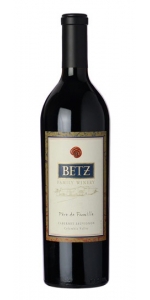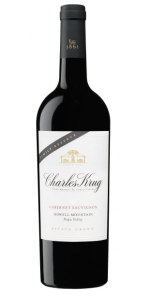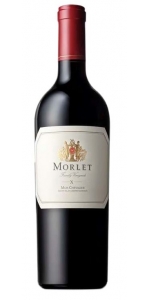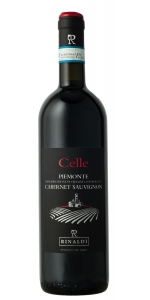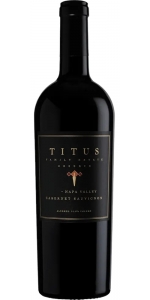Sbragia Family Cabernet Sauvignon Monte Rosso 2009
| Country: | United States |
| Regions: | California California (Sonoma County) |
| Winery: | Sbragia Family Vineyards |
| Grape Type: | Cabernet Sauvignon |
| Organic: | Yes |
| Vintage: | 2009 |
| Bottle Size: | 750 ml |
Betz Family Cabernet Sauvignon Pere de Famille is 88% Cabernet Sauvignon, 10% Petit Verdot and 2% Merlot
Review:
"This is a wine for the ages. Aromas of thyme, the blackest of cherries, licorice, bay leaf and spice are followed by outright delicious, plump fruit flavors. There's a whole lot of primary fruit, with ample structure to hang it all on, along with plenty of depth and intensity. The finish is near endless. It flat-out impresses, with remarkable intensity. Best from 2028 to 2038. - SEAN P. SULLIVAN."
- Wine Enthusiast (September 2021), 95 pts
"A firm, polished red with aromas of blackberry, iodine, tobacco leaf, cocoa and cedar. It’s medium-to full-bodied with firm, chewy tannins. Structured, layered and focused. Lots going on, with a long finish. Try from 2023."
- James Suckling (May 2021), 95 pts
"Incorporating 10% Petit Verdot and 2% Merlot from a mix of sites in the Columbia Valley, the 2018 Cabernet Sauvignon Père De Famille reveals a healthy ruby/purple hue to go with beautiful cassis fruits interwoven with notions of dried rose petals, violets, cedary spice, and chalky minerality. Medium to full-bodied, reasonably well concentrated, yet elegant and beautifully balanced, it opens up nicely with time in the glass and will benefit from 2-4 years of bottle age and keep for 20 years."
- Jeb Dunnuck (May 2021), 95 pts
Charles Krug Family Reserve Howell Mountain Cabernet Sauvignon is made from 100 percent Napa Cabernet Sauvignon.
Rising 1,650 feet above the Napa Valley floor on the southwestside of Howell Mountain, the Family Reserve Howell MountainCabernet Sauvignon sits above the fog line. The distinctiveclimate, along with volcanic and iron-rich red soils, producefruit with great balance and intensity.
Review:
The 2017 Cabernet Sauvignon Limited Release Cold Springs is the most distinctive of the wines in this range of limited-release Cabernets from Charles Krug. Gravel, licorice, menthol and spice all develop in a Howell Mountain Cabernet endowed with tremendous class and nuance.
-Vinous 92 Points
Morlet Family Vineyards Mon Chevalier Cabernet Sauvignon is made from 94% Cabernet Sauvignon 6% Cabernet Franc .
Located on the hillsides of Knights Valley, near Calistoga, this vineyard benefits from its proximity to Mount St. Helena, whose warm and windy climate is ideal for the long ripening of the Bordeaux red varietals. Handcrafted by using classical winemaking techniques, this special wine is dedicated to our son, Paul Morlet.
Dark red with a hue of purple. Intense and complex bouquet of red, black and blue berries intermixed with notes of blueberries, minerals (graphite, wet river rocks) licorice, fresh blond tobacco and a hint of lavender. Full bodied, the palate is reminiscent of the nose, with a richly tannic yet round frame and a great intensity. The hillside tannins and the classical aromatic complexity create a harmonious ensemble, leading to a very long and elegant finish. Built to age for decades, this collectible wine opens up after a few years of cellaring and is particularly representative of this special vineyard from the hillside of Knights Valley. Mon Chevalier features the interaction of the loamy, well drained and rocky volcanic soil, the typical sunny mountain climate and the low-interventionistic Morlet winemaking approach.
Propietary Name Mon Chevalier
Name Meaning My Knight Named after our son, Paul Morlet
Type of wine Vineyard designated
Appellation Knights Valley
Vineyard singularity Morlet Family Estate Hillside 1100-1200 feet elevation Rhyolitic, loam & volcanic ash
Typical harvest date End of October
Picking Manual, small lugs, refer truck
Sorting Cluster by cluster, berry per berry
Fermentation Through native yeast Tank and Puncheons
Upbringing 16 months French oak from artisan coopers
Bottling Unfiltered
Cellaring time Decades
Serving Room temperature
Decanting recommended
Review:
The 2017 'Mon Chevalier' is rich, deep and unctuous, with all the character that makes wines from this site so exciting. Graphite, inky blue/purplish fruit, spice and lavender infuse the 2017 with tremendous complexity. In the glass, the 2017 is savory, rich and expansive, not to mention hugely appealing.
-Vinous 96 Points
Morlet Family Vineyards Mon Chevalier Cabernet Sauvignon is made from Cabernet Sauvignon (86%) Cabernet Franc (8%) Merlot (3%) Malbec (2%) Petit Verdot (1%) .
Located on the hillsides of Knights Valley, near Calistoga, this vineyard benefits from its proximity to Mount St. Helena, whose warm and windy climate is ideal for the long ripening of the Bordeaux red varietals. Handcrafted by using classical winemaking techniques, this special wine is dedicated to our son, Paul Morlet.
Dark red with a hue of purple. Intense and complex bouquet of red, black and blue berries intermixed with notes of blueberries, minerals (graphite, wet river rocks) licorice, fresh blond tobacco and a hint of lavender. Full bodied, the palate is reminiscent of the nose, with a richly tannic yet round frame and a great intensity. The hillside tannins and the classical aromatic complexity create a harmonious ensemble, leading to a very long and elegant finish. Built to age for decades, this collectible wine opens up after a few years of cellaring and is particularly representative of this special vineyard from the hillside of Knights Valley. Mon Chevalier features the interaction of the loamy, well drained and rocky volcanic soil, the typical sunny mountain climate and the low-interventionistic Morlet winemaking approach.
Property Name: Mon Chevalier
Name Meaning My Knight Named after our son, Paul Morlet
Type of wine Vineyard designated
Appellation Knights Valley
Vineyard singularity Morlet Family Estate Hillside 1100-1200 feet elevation Rhyolitic, loam & volcanic ash
Typical harvest date End of October
Picking Manual, small lugs, refer truck
Sorting Cluster by cluster, berry per berry
Fermentation Through native yeast Tank and Puncheons
Upbringing 16 months French oak from artisan coopers
Bottling Unfiltered
Cellaring time Decades
Serving Room temperature
Decanting recommended
Review:
The 2018 Cabernet Sauvignon Mon Chevalier comes from the Knights Valley, just north of Napa Valley in the larger Sonoma County, and it always seems to me to have one foot in Napa and one foot in Sonoma. Boasting a similar ruby/purple color (as do all of the releases here), it’s slightly more reserved and stately (knightly, if you will), with building aromas and flavors of blackcurrants, toasted bread, dried violets, baking spices, and loamy earth. These carry to a pure, full-bodied, multi-dimensional Cabernet that’s flawlessly balanced, has ripe yet certainly present tannins, a notable sense of minerality, and a great, great finish. It’s just another incredible wine from Luc Morlet that can be drunk today with ample pleasure or cellared for 20-30 years if, for some reason, you feel the need to delay gratification.
-Jeb Dunnuck 99 Points
Rinaldi Celle Piemonte Cabernet Sauvignon is made from 100% Cabernet Sauvignon.
Intense red color with purple reflections. The characteristic aroma is pleasant and dominated by notes of blackberry, plum and black currant. A short passage in wood gives it elegance and complexity.
The 2021 Titus Family Estate Reserve embodies the depth, concentration, and beauty of our Ehlers Lane vineyard with grace and elegance. A core of Blueberry, black currant, mulberry and warm coffee are rounded out with hints of lilac and maduro wrapped cigar. Inkiness in the glass gives the wine depth and length with rich finely knit tannins melting to chocolate pot de crème intensity. Crème de cassis and berry tart notes yield to espresso and rich oak on the finish as the palate endures. Enjoy 2025-2041.
Review:
Lastly, the 2021 Cabernet Sauvignon Family Estate Reserve is based on 87% Cabernet Sauvignon, 9.5% Petit Verdot, and the rest Malbec. It's a touch more focused and linear compared to the Imperatus, but I love the purity and precision in its cr me de cassis, espresso, classy oak, and spicy, floral aromatics. Medium to full-bodied on the palate, with fine tannins and a seamless, layered mouthfeel, as well as ripe tannins, it's going to benefit from 2-3 years in the cellar and evolve for 15 years with ease.
-Jed Dunnuck 94 Points
The 2009 Cabernet Sauvignon Monte Rosso Vineyard hits the palate with juicy dark berries, grilled herbs, cedar and tobacco. There is lovely purity to the fruit backed up by pure, distinctive Monte Rosso tannins. A big, powerful finish rounds things out in style. This is a reference point Sonoma Cabernet Sauvignon. Anticipated maturity: 2014-2024.
92 points, Robert Parker's Wine Advocate (Issue # 204 - Dec 2012)
Good ruby-red. Aroma of blackberry, menthol, cocoa powder and tobacco. Sweet and creamy on the palate, with strong licorice and minerals notes (from the red soil?). Finishes chewy, savory and long, with very good breadth and an earthy nuance. Proprietor/winemaker Ed Sbragia describes Monte Rosso as "the grand cru vineyard of Sonoma County."
90-92 points, Stephen Tanzer's Int'l Wine Cellar (May 2012)
Sbragia Family Vineyards Estate
Sbragia Family Vineyards is located in the beautiful Dry Creek Valley and is where winemakers, Ed and Adam Sbragia, make their limited production wine. A third generation Dry Creek Valley vintner, Ed is well known for his position as Winemaster at Beringer Vineyards in Napa. He began working at Beringer in 1976, working under legendary winemaker, Myron Nighingale. During his career, Ed has become one of California’s most talented and respected winemakers. The Sbragia family history runs deep in the Dry Creek Valley. Ed’s grandfather came to the valley from Tuscany in 1904, where he worked in wineries, starting at the Italian Swiss Colony. Ed’s father, Gino, acquired his own vineyards near Healdsburg, growing zinfandel grapes for sale and home winemaking. "He made excellent wine," says Ed, "and he taught me that making wine is a very natural process – that good grapes and good techniques will always make good red wine."
In 2001, Ed created his own label, Sbragia Family Vineyards, to focus on making limited, individual lots of wine from grapes grown in select blocks of his favorite vineyards in Dry Creek, Napa, and Sonoma. Five of the wines, including Sauvignon Blanc, Chardonnay, Merlot and two Zinfandels, are sourced from Sbragia family-owned estate vineyards that range in size from five to thirteen acres. Like his tenure with Beringer, Ed continues to make “big reds,” including Cabernets from Howell Mountain, Mt. Veeder, Sonoma Mountain and Alexander Valley. The wines all exhibit Ed’s distinctive and acclaimed style – big, rich, balanced and polished.
The Sbragia Family Vineyard
At Sbragia Family Vineyards, we source grapes from about 50 acres of family-owned vineyards the Sbragias have been farming for over 100 years in Historic Dry Creek Valley. Ed & Adam also purchase grapes from their favorite vineyards throughout Sonoma and Napa Valleys. I’ve always had one foot in Sonoma and the other in Napa. Both areas mean a lot to me emotionally. I’m more attached to Dry Creek because it’s where I raised my kids. But the wines that I’ve made at Beringer are like children, so Napa is also a very special place to me.
Dry Creek Valley:
Dry Creek Valley, a premium winegrowing region, is located in Northern Sonoma County, California, only an hour north of the Golden Gate Bridge/San Francisco.
Renowned for its idyllic undisturbed beauty, Dry Creek Valley is home to over 9,000 acres of vineyards that carpet the intimate 16-mile long x 2-mile wide valley, floor to hillside. With a grape growing history going back 140 years – one of the longest in California – producing premium winegrapes is core to this region. In fact, the valley boasts one of the densest concentrations of Old Vine Zinfandel in the world.
Alexander Valley:
Located at the northern end of Sonoma County, the Alexander Valley is 22 miles long and varies in width from two to seven miles. On the hillsides to the east and west, and adjacent to the beautiful Russian River winding along the valley floor, the valley is home to a diversity of microclimates that support the growth of many wine grape varieties including Cabernet Sauvignon, Zinfandel, Chardonnay, Sauvignon Blanc, and many more.
Sonoma Valley:
The Sonoma Valley AVA centers on the Sonoma Valley (also known as The Valley of the Moon) in the southern portion of the county. The appellation is bordered by two mountain ranges: the Mayacamas Mountains to the east and the Sonoma Mountains to the west.
Along with being the area where so much of Sonoma County's winemaking history took place, the area is known for its unique terroir, with Sonoma Mountain protecting the area from the wet and cool influence of the nearby Pacific Ocean.
One finds a wide disparity between valley floor and mountain soils; those found in flatter, valley areas tend to be quite fertile, loamy and have better water-retention while the soils at higher elevations are meager, rocky and well-drained. In general, the structure, rather than the composition of the soil, is the deciding factor where grape plantings are concerned.
Napa Valley:
Though just 30 miles long and a few miles wide, Napa Valley is home to diverse microclimates and soils uniquely suited to the cultivation of a variety of fine wine grapes. Among the internationally acclaimed wines produced in this small region are Cabernet Sauvignon, Merlot, Pinot Noir, Chardonnay, Sauvignon Blanc, Zinfandel and Cabernet Franc.
- back
All older vintage wines have been purchased from a single collectors cellar. Pictures can be requested before shipment.
Le Jade Picpoul de Pinet is made from 100% Picpoul de Pinet
Pale straw color. Delicate white flower, citrus and juicy pear aromas. Fresh, crisp, and bright acidity with mineral and saline accents. Well-balanced and easy-drinking.
A refreshing treat laced up with snappy food-friendly acidity.
Picpoul Le Jade makes a classic match with oysters on the half shell and goes very well with exotic food in general. Picpoul means lip-smacking good.
SOIL : Clay and limestone soil just a few kilometres from the reputed Etang de Thau (salted water lagoon) overlooking the Mediterranean town of Sète.
VINIFICATION : Grapes are harvested at 12°- 13° maturity
Skin maceration for several hours
Selection of drained juice after undergoing pneumatic pressure.
Cold double decantation.
Thermoregulated fermentation at 16°C
No malolactic fermentation.


